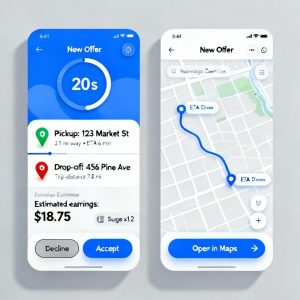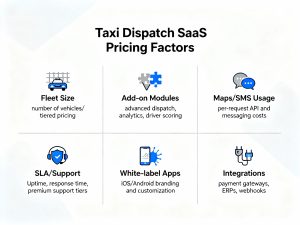Cloud-Based Taxi Dispatch Software: Key Features, Pricing Factors, and ROI
Cloud-Based Taxi Dispatch Software: Key Features, Pricing Factors, and ROI
Overview
Cloud-based taxi dispatch software has become the backbone of modern fleet operations, enabling taxi companies and private hire operators to automate bookings, optimize driver allocation, and deliver Uber-like customer experiences without heavy upfront IT investment. This guide breaks down what it is, the essential features to look for, how pricing typically works, and how to calculate ROI.

What Is Cloud-Based Taxi Dispatch Software?
Cloud-based taxi dispatch software is a SaaS platform that manages end-to-end ride operations—from booking and fare estimation to driver assignment, live tracking, and payments—hosted on remote servers and accessed via web dashboards and mobile apps. Unlike on-premise systems, cloud platforms offer faster deployment, automatic updates, elastic scaling, and lower maintenance overhead.

Who Is It For?
- Taxi fleets (5–5,000+ vehicles)
- Private hire, limo, and shuttle operators
- Corporate transport providers and NEMT services
- City/regional dispatch cooperatives
Key Features to Look For
1) Intelligent Dispatch and Auto-Assignment
- Rule-based and AI-assisted matching (nearest driver, ETA, driver score, surge areas)
- Queueing and prioritization (airport stands, zones)
- Reassignment and fallback logic when drivers decline or time out
- Configurable constraints (vehicle class, capacity, wheelchair access)
Why it matters: Minimizes wait times and deadhead miles, improves driver utilization.
2) Real-Time GPS Tracking and ETAs

- Live driver location and trip status
- Multi-source traffic data for accurate ETAs
- Breadcrumb trails and post-trip route replay
Why it matters: Transparency for passengers and controllers, fewer “Where’s my ride?” calls.
3) Multichannel Booking
- Passenger apps (iOS/Android) with fare estimates and saved payments
- Web booking widget for your site
- Call-center/dispatcher console with quick booking and repeat-customer profiles
- Optional integrations: WhatsApp/SMS bots, corporate booking portals
Why it matters: Meet customers where they are; reduce missed calls and manual errors.
4) Driver App Essentials
- Job offers with countdown, accept/decline, and navigation deep links
- In-app meter, surge indicators, heatmaps
- Compliance prompts (vehicle docs, selfie/ID checks)
- Offline mode and battery/data usage optimization
Why it matters: Faster job turnaround and fewer dispatch bottlenecks.
5) Pricing, Payments, and Invoicing
- Configurable fare rules (time/distance, zones, flat rates, surge)
- Multiple payment methods (card, wallet, cash, corporate invoice)
- Automatic invoice generation and reconciliation
- Tips, tolls, and extras handling
Why it matters: Revenue accuracy and reduced admin workload.
6) Customer Experience and Safety
- Real-time ride tracking share links
- Driver/vehicle profiles and ratings
- SOS and incident reporting workflows
- Lost-and-found management
Why it matters: Trust drives repeat business and corporate contracts.
7) Reporting and Analytics
- KPIs: utilization, acceptance rate, cancellations, on-time pickup %, average wait time
- Driver earnings and payout reports
- Heatmaps for demand forecasting
- Export to CSV/BI tools; scheduled email reports
Why it matters: Data-driven optimization of supply, pricing, and marketing.
8) Integrations and APIs
- Payment gateways, accounting (e.g., Xero/QuickBooks), CRM, marketing automation
- Mapping/routing providers (Google Maps, Mapbox)
- Webhooks and REST APIs for custom workflows
Why it matters: Future-proofs your stack and reduces manual data entry.
9) Admin Controls and Compliance
- Role-based access control and audit logs
- GDPR/CCPA features: data retention, anonymization, consent tracking
- Document management for drivers and vehicles
- SLA/uptime visibility and disaster recovery posture
Why it matters: Reduces risk and ensures regulatory compliance.
10) Scalability and Reliability
- Auto-scaling to handle peak demand (storms, events, holidays)
- High availability architecture, CDN, and robust mobile notifications
- Versioned rollouts and rollback safety
Why it matters: Keeps operations running during spikes when revenue is highest.
Pricing Factors: What Drives the Cost?
Cloud taxi dispatch platforms typically use monthly subscription models with add-on modules. Expect tiered pricing.
Key cost drivers:
- Fleet size and active drivers: Per-vehicle or per-driver pricing is common.
- Feature modules: Advanced routing, BI, corporate billing, IVR, white-label apps may be add-ons.
- White-labeling and branding: Custom-branded passenger/driver apps and app store publication.
- Geography and maps usage: Map/traffic/route API calls can influence costs.
- SMS/Voice usage: Notification and IVR costs vary by country and volume.
- Support and SLAs: Priority support, dedicated CSM, onboarding/training packages.
- Integrations: Custom API work, accounting/payments connectors, single sign-on (SSO).
- Data retention and analytics depth: Historical data storage and advanced dashboards.
Typical ranges (indicative, not vendor-specific):
- Small fleets (up to 25 vehicles): $100–$600/month base, plus usage (SMS, maps).
- Mid-size (25–200 vehicles): $500–$3,000/month; discounts at scale.
- Large/enterprise (200+): Custom pricing; volume discounts, advanced SLAs.
- White-label apps: One-time setup $1k–$10k, plus annual maintenance.
Tip: Always model total cost of ownership (TCO), including telecom, app store fees, and internal admin time.
How to Calculate ROI
A practical ROI framework focuses on revenue lift and cost savings.
- Baseline your current metrics
- Average trips/day
- Average fare
- Acceptance rate, cancellation rate
- Average passenger wait time
- Driver utilization (% of time on trip)
- Monthly operating costs (dispatchers, telecom, fuel subsidies, no-shows)
- Identify value levers from the new system
- Increased acceptance rate and reduced wait times
- Fewer no-shows due to accurate ETAs and notifications
- Lower deadhead miles with smarter auto-assignment
- Higher driver retention (better earnings visibility, fewer idle gaps)
- Reduced admin and billing errors
- New revenue: corporate accounts, dynamic pricing, upsells
- Quantify the impact with a simple model
Let:
- T = trips per month
- F = average fare
- m = gross margin percentage
- Δr = percentage increase in completed trips (from efficiency/experience)
- Δc = monthly cost savings (telecom, admin hours, fraud, chargebacks)
- SaaS = monthly software + usage costs
Monthly incremental gross profit:
ΔGP = (T × Δr × F × m) + Δc − SaaS
ROI%:
ROI = (ΔGP / SaaS) × 100
Example:
- T = 20,000 trips/month
- F = $12 average fare
- m = 35%
- Δr = 6% increase in completed trips
- Δc = $1,500/month savings
- SaaS = $2,200/month
Compute:
- Incremental margin from trips = 20,000 × 0.06 × 12 × 0.35 = $5,040
- Total ΔGP = $5,040 + $1,500 − $2,200 = $4,340
- ROI = ($4,340 / $2,200) × 100 ≈ 197%
Payback period:
Payback months = Setup costs / ΔGP
If setup = $4,000 → Payback ≈ 0.92 months.
- Track post-deployment
- Compare 30/60/90-day KPIs to baseline
- Validate assumptions and fine-tune auto-assign rules, pricing, and zones
Implementation Checklist
- Define zones and pricing rules (time/distance, minimums, surge windows)
- Upload driver and vehicle documents; set renewal automation
- Configure auto-assign logic and fallback timing
- Integrate payment gateway and accounting
- Set SMS/email templates, multilingual support, and IVR if needed
- Establish corporate billing profiles and SLAs
- Enable analytics dashboards and schedule weekly KPI reports
- Run a pilot with 10–20% of drivers before fleet-wide rollout
- Train dispatchers and drivers; provide quick-reference guides
- Set incident response and data privacy policies
Common Pitfalls to Avoid
- Over-customizing too early; start with standard workflows, then iterate.
- Ignoring driver UX; a clunky driver app will tank acceptance rates.
- Underestimating telecom costs; optimize SMS cadence and use push notifications.
- Poor data hygiene; enforce document expiries and vehicle categories.
- No change management; train, incentivize, and communicate KPIs clearly.
The Bottom Line
Cloud-based taxi dispatch software can deliver rapid payback by increasing completed trips, improving driver utilization, and reducing admin and telecom overhead. Prioritize platforms with robust auto-assignment, reliable mobile apps, transparent analytics, and flexible integrations. Model your ROI upfront, run a measured pilot, and iterate based on data.
If you want, share your fleet size, service areas, and current KPIs, and I’ll build a tailored ROI model and a feature checklist suited to your operation.

Comments
Post a Comment